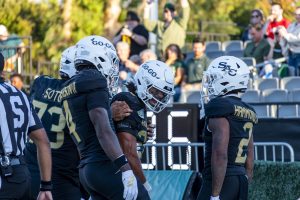Sac State offers real college experience
November 19, 2014
Sacramento State’s motto “Do the unexpected” seems more relevant than ever in a state that pits college against college in an attempt to be the best.
This reporter knows first-hand the slanted remarks made about the CSU system and the constant comparison there is to a UC.
I live in Davis and I am often asked at work where I study. Without fail, I get a silent bite-the-lip response when I say I go to school at Sac State.
The comments I sometimes receive go beyond Aggie loyalty and stem from a much deeper judgment call that CSUs are somehow inferior to a UC education.
“I’m sure if I told people that I went to UC Davis that I would get a different response than if I said I went to CSUS,” senior nutrition major Morgen Spires said. “And I think that’s flawed.”
But it is true that California’s universities are placed on a tier system.
The Master Plan for Higher Education in California was created in 1960 and laid foundation for the three-tier system for UCs, CSUs and community colleges.
The system ranks UCs as tier one, CSUs second and community colleges as tier three.
“I guess that makes the world go ‘round,” Spires said about ranking California colleges. “Society likes to rank and compare things.”
However, the reasons behind the rankings are worth exploring to understand why some distorted perceptions are drawn.
Lorenzo Smith is the Dean of College of Engineering and Computer Science at Sac State and explained the system is tiered for many reasons, but none have anything to do with predicting student success.
Smith said a large part of the ranking system has to do with university graduation rates.
“Many of our students are working,” Smith said about Sac State. “They are working full-time or part-time getting that industry experience–that is paying dividends for them–so naturally it is going to take a little bit longer for them to graduate.”
But that industry experience, Smith said, really does help prepare students for success.
“I can’t tell you how many people that say how much they appreciate our graduates because they are very hands-on, but they understand the realities of industry,” Smith said.
He said UC graduation rates are most likely higher because, he imagines, they have a higher percentage of full-time students.
However, that is not to say that UC students are above or below CSU students in any way, they just have different experiences and follow a different path to graduation.
Regardless, Smith said a student’s alma mater has less to do with career success than some may perceive, and successful students graduate from UCs and CSUs alike.
“The way you are successful in life is not just that school–it’s your work ethic, your hunger for knowledge,” Smith said. “All those things play a big role in a student’s success as they go into industry.”
Another difference between UCs and CSUs is the attention surrounding research.
Smith said UCs primarily focus on fundamental research, like grant work, while CSUs focus on applied research, which directly affect student learning and preparedness.
Ankit Gupta and Sanjeed Sawant are students who benefit from the applied research philosophy of Sac State.
Gupta is a graduate student studying computer programming and Sawant is an electrical and electronic engineering graduate student.
Both came to the U.S. from India with hopes of working for Intel, and both said Sac State’s connections with industry could help them get there.
“This was my first choice,” Gupta said about choosing from several schools in California.
Regardless of a student’s college, major or life experiences, everyone who walks to accept that diploma is accomplishing something worth applause.
Amy Scott is a senior anthropology major and said, although Sac State was not her first choice because she wanted to go away to school, that she now has “a deeply-rooted pride for being here”.
Despite the swayed perceptions of our school, it is important to note Sac State is still rich with culture, knowledge and, above all, the drive to succeed.
“Some people have perceptions, and that’s okay,” Smith said. “But when those people come to campus and see some of the great things that our students are doing–and our faculty are doing–they might change that perception.”
























































































































